I’m happy to do this story about the American Humane Hero Vet Awards 2017 Contest!
For the first time, all the vet heroes are all cat heroes and none of them perform the inhumane, cruel, and unnecessary procedure of declawing.
They are true animal advocates in every way and they think of the animal’s needs first! Let’s all thank them and celebrate what they do to heal and help animals and vote for your favorite one!
I reached out to each of these vets and asked them if they would give me a paragraph about their stance on declawing. All of their statements are listed below.
Here is the American Humane’s position statement on declawing. [button href=”https://www.americanhumane.org/position-statement/declawing-cats/” color=”red” newwindow=”yes”] American Humane Declaw Position[/button] They have a good stance until the end when they say, ” If you have tried all alternatives to solve destructive scratching problems, it is better to declaw the animal than abandon it.”
You must be a resident of the United States to vote for these humane vets and can vote once a day, until July 27th. You also have to vote for the vet tech award too. Here is more about the contest and the link to make your vote! [button href=”http://herovetawards.org/vote/” color=”red” newwindow=”yes”] Vote For A Hero Vet[/button]
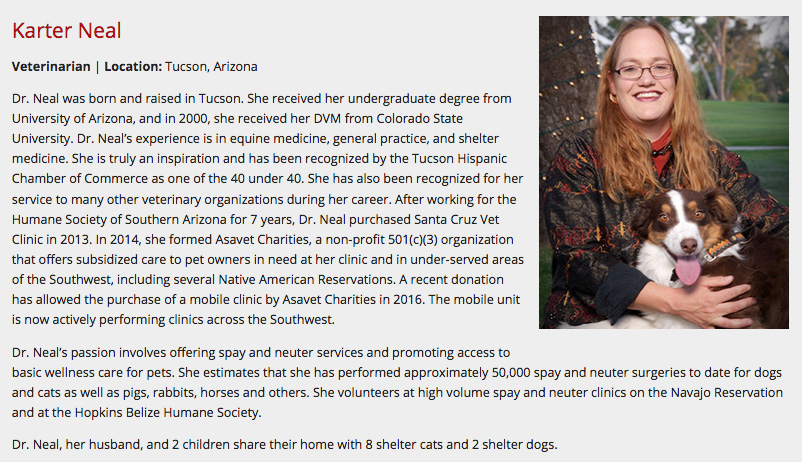
Dr Karter Neal’s statement-
There are many reasons why I do not declaw cats. In veterinary school, I was taught how to and did perform the procedure and as a new vet, a couple of my employers expected me to do the procedure. Growing up, our family always had our cats declawed, my parents stating they didn’t want to have damage done to the furniture. In my career, I have likely declawed about 100 cats. Now, having worked at a shelter for many years and having met hundreds of declawed cats and witnessed many cats recovering from the procedure, I have chosen to not make it part of my practice and to explain to clients and potential “declawers” why I do not recommend it.
Declawing is, essentially, the equivalent of amputating the tips of your fingers off at the last joint. A couple of the techniques for declawing are prone to leaving small fragments of this last digit (toe) at the bottom of each toe and can leave what could be compared to “rocks or pebbles in your shoes” that one feels every time you take a step. Most vets today are much more conscious about perioperative pain control, as it is a very painful procedure, and use better medicines and equipment like lasers which help reduce morbidity and speed up the healing process.
Removal of the last digit changes the weight bearing load on the foot, the foot pad, remaining digit, and the leg itself. This can make it more painful and difficult to walk, jump, run, display normal cat behavior, etc. In my clinical experience, I find that declawed cats brought to shelters, in general, declawed cats have more behavioral abnormalities, and most shelter workers will confirm this perception. Because these cats no longer have normal defenses with claws, declawed cats appear to be much more likely to resort to biting in the shelter and clinic environment when stressed. They also, in general, seem to have a lower threshold for stress and tend to vocalize more loudly (hiss, growl), etc, then the average undeclawed shelter cat. Of course, declawed cats that are allowed to roam outside are of even greater risk of predation as they are not able to run, jump, climb to safety, or use their claws as defense if they are chased by a predator. Here in Tucson, cats are heavily predated by wildlife; for this reason our family does not allow our cats outside. We commonly see bobcats, coyotes, owls, and hawks in our neighborhood on a daily basis, and declawed cats outside are at a greater risk of mortality due to traumatic events. There are always exceptions to the rule, of course; I have seen declawed cats climb trees very well, express normal kneading and scratching behavior, and are behaviorally well adapted. However, declawing, in my opinion, does increase the chance of developing chronic pain or behavioral issues arising during the cats life whereas that risk can be lowered or reduced by simply choosing not to declaw.
I currently own 7 shelter cats and none of them are declawed. We trim nails regularly, which helps maintain healthy nails and claws, and we offer toys, scratchers, and play time, to help them express normal behaviors. We are diligent about buying furniture covers and scratchers to cover corners of new furniture, chairs, and couches.
There are products on the market that cover the claw with cute plastic tips….some cat will not tolerate these, but many can get used to them. They do require some patience to apply and maintain, but can be a very effective tool.
Over the years, I have come to realize that I am uncomfortable with inflicting this procedure on cats….they often cannot walk for a couple of days and have severe pain post-operatively. Declawing can set them up for chronic joint and bone pain as they age. I have had to “re-declaw” many cats who have had procedure done incorrectly or have had deformed claws regrow from incomplete resection. Some of these have cats were ones I did myself in the early years and many were from other vets; just as with anything, there is a learning curve in performing the procedure and many of us have made mistakes, even without knowing it, when declawing. I truly feel very bad for those cats I declawed. Now that I am “older and wiser”, I am grateful that I am in a position where I can choose to say no and not offer the procedure and try to educate owners why they shouldn’t do this.
————-
*** Dr Karter Neal’s Santa Cruz Vet practice is a no-declaw practice
![]()
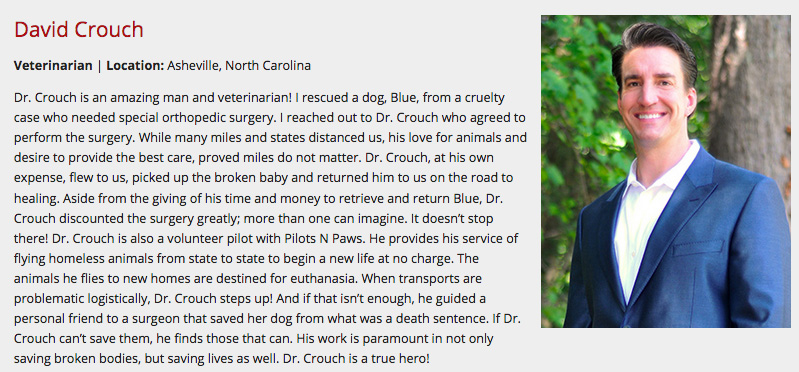
Dr David Crouch’s statement-
I am in complete agreement with the ASPCA’s stance on why declawing cats in unnecessary and inhumane: “A variety of alternatives exist to manage natural scratching behavior and to prevent injury from cat scratches. These include having a cat’s nails trimmed regularly in order to blunt the tips, providing scratching pads, posts and other appealing structures for the cat to use and employing behavior modification techniques to induce the cat to use them, using deterrents such as double-sided tape (e.g., Sticky Paws®) to protect furnishings, and covering the claws with soft temporary pads (e.g., Soft Claws®).”
I do not offer declawing, debarking, ear cropping or tail docking at my veterinary surgery hospital. I urge my colleagues to adopt the same philosophy.
————–
*** Dr David Crouch’s Western Carolina Veterinary Surgery Hospital is a no-declaw hospital.
![]()
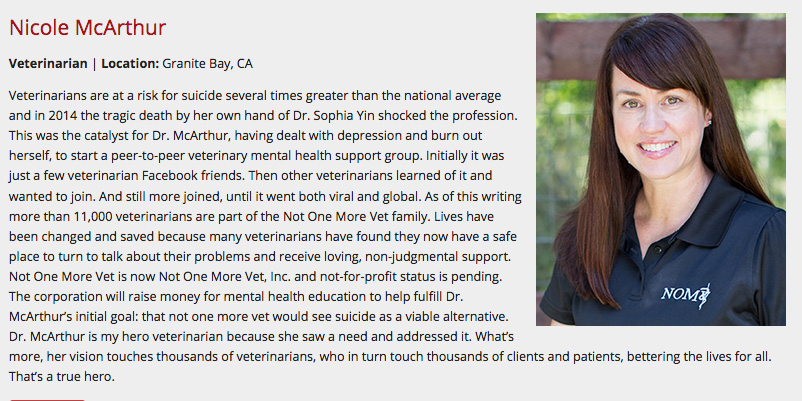
*** Dr Nicole McArthur doesn’t declaw cats but the owner vet of the practice where she works counsels cat owners about the humane alternatives but if an owner is going to euthanize their cat, get rid of the cat, or is tearing up the house, he will declaw the cat as a last resort according to an employee at the practice.
![]()
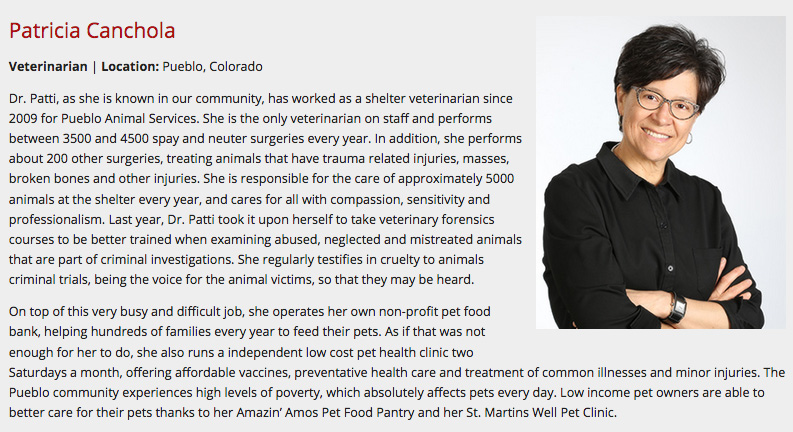
Dr Patricia Canchola’s statement-
As an AAHA practice owner from 2004-2009 I performed surgical declaws under strict guidelines. After educating the client on all the other options available in addition to the surgical procedure and aftercare there are many that elected to proceed.
I felt comfortable with the surgical approach which utilized surgical laser in addition to nerve blocks, appropriate pre-surgical and post-surgical pain control.
In 2009 I made to move to shelter medicine where this is no longer a surgical procedure that I perform.
When asked by the general public about this procedure I do my very best to educate them about alternatives to declawing and if they persist I encourage them to research the use of surgical laser and pain control.
I can honestly recall 2 phone calls in the last year from individuals asking for the surgery. In both cases after I educated them on what a declaw is and the pain/complications, they pursue alternatives to declawing.
At this point in my shelter medicine career a single/multiple digit declaw would only be used when medically necessary secondary to trauma or advance disease/infection.”
![]()
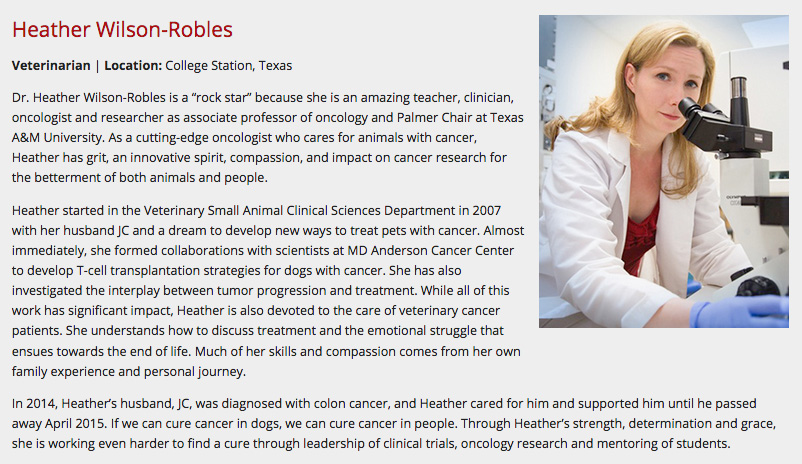
Dr Heather Wilson-Robles’ statement-
As a veterinary oncologist declawing is not commonly part of my everyday practice. The majority of my patients are geriatric and beyond this type of discussion, however, I am a firm believer in trying everything possible to avoid declawing. I do not declaw my own personal cats and keep many scratch posts and pads all around the house for our kitty, Pete. I believe that with the advent of ‘Soft Paws’ and other similar nail covers it is possible to avoid declawing in our furry kitty friends.
*** The Small Animal Hospital at Texas A&M declaws cats. According to two employees at the hospital, their “declawing machine” (a laser) has been down for a couple months because they are waiting for a new part. Once they get the part and fix their “declawing machine” they will offer declaw procedures and charge $380 for them. Dr Wilson-Robles informed me that she has no control over the policies of this hospital.
![]()
![]()
PLEASE VOTE FOR YOUR FAVORITE HUMANE HERO VET! You must be a resident of the United States to vote for these humane vets and can vote once a day, until July 27th. You also have to vote for the vet tech award too. Here is more about the contest and the link to make your vote! [button href=”http://herovetawards.org/vote/” color=”red” newwindow=”yes”] Vote For A Hero Vet[/button]
Hopefully this will inspire American Humane to have a position statement that completely condemns this inhumane, mutilating, and unnecessary procedure. Hopefully this will inspire AAHA and AAFP (Cat Friendly) to NOT allow declawing at their veterinary hospitals and “Cat Friendly” practices. Hopefully it will inspire the AVMA to stop lying about this harmful procedure and update their position statement to reflect the facts about this mutilating procedure. [button href=”https://citythekitty.org/american-veterinary-money-association-deception-for-profits/” newwindow=”yes”] AVMA’s Declawing Lies and Deception[/button]
If you want to be my hero, please take 20 seconds to sign each of these important petitions to help end declawing. Your signature WILL make a difference and you will be a part of cat history!
http://bit.ly/AAHAstopDeclawing
http://bit.ly/CatVetsStopDeclawing
http://bit.ly/CornellCondemnDeclawing
The Paw Project’s petitions
http://bit.ly/NJantideclawbill
http://bit.ly/NYantideclawBill
